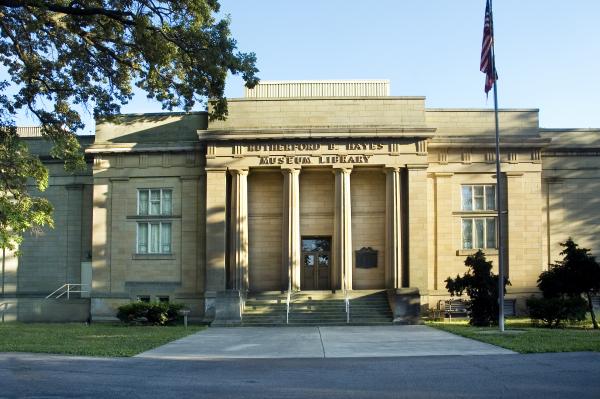KID REPORTERS’ NOTEBOOK
Remembering Rutherford B. Hayes
Nolan with education coordinator Joan Eardly at the Rutherford B. Hayes Presidential Library & Museums in Fremont, Ohio
The city of Fremont, Ohio, is home to the first presidential library ever to be built in the United States. It honors Rutherford B. Hayes, who served as president from 1877 until 1881.
During a recent visit to the Rutherford B. Hayes Presidential Library & Museums, I learned more about the 19th president from education coordinator Joan Eardly, marketing and communications coordinator Kristina Smith, and curator Dustin McLochlin.
Hayes lived on a 25-acre estate in Fremont called Spiegel Grove with his wife, Lucy Webb Hayes, and their family. It was their son, Webb Cook Hayes, who led the effort to establish a presidential center there after they died.
“Visitors can tour the couple’s 31-room mansion, visit the library and museum, and walk a mile of paved trails,” Eardly said. Hayes and his wife are buried on the grounds.

Hayes’s son made sure that the former president’s papers were preserved at the family’s estate in Ohio.
SERVING IN THE ARMY AND GOVERNMENT
Hayes was born in Ohio in 1822. After graduating from Kenyon College at the age of 20, he attended Harvard Law School. “He was the first U.S. President to hold a degree in law, not just a law apprenticeship,” Smith said.
When the Civil War began in 1861, Hayes joined efforts to stop the South from seceding. He became major general in the Union Army and was wounded in battle several times.
According to Smith, Hayes’s Civil War jacket is one of the most popular artifacts in the presidential library.
“You can see a bullet hole in the sleeve of the jacket,” Eardly said.
While he was still in the Army, Hayes ran for the U.S. House of Representatives. He was elected and served from 1865 until 1867, later becoming the governor of Ohio.
A CONTROVERSIAL ELECTION
In the 1876 presidential election, the Republican Party chose Hayes as their candidate. He ran against Democrat Samuel J. Tilden of New York and appeared to lose the popular vote.
“Hayes was only determined the winner after Congress created an electoral commission which investigated the vote totals,” McLochlin said. “Since Hayes lost the popular vote, and a special commission determined him the winner, people called him things like ‘Rutherfraud’ Hayes.”
Once in office, Hayes spent a great deal of time fighting for civil service reform, Smith said. He hoped to prevent unqualified people from being named to government positions simply because they had been influential in elections.

Nolan in front of a portrait of Rutherford B. Hayes, the 19th U.S. President
AT HOME AND ABROAD
While president, Hayes often traveled by train to give speeches and connect with ordinary Americans. “He wanted to unite the nation, which was still divided after the Civil War,” Smith explained.
After a bitter war over slavery, Hayes was determined to move in a new direction with race relations. The government slowly moved away from stationing members of the military in the South.
“Hayes hoped to work with Southern Republicans to uphold black civil rights,” McLochlin said. However, he was unsuccessful, “and race relations deteriorated.”
Hayes did have a major success in South America. He arbitrated a land dispute after a long war between Argentina, Brazil, and Paraguay. The dispute was over a region called the Gran Chaco, which makes up about 60 percent of Paraguay’s total land. Hayes's efforts meant that Paraguay could retain the land.
“This made Hayes a national hero in Paraguay,” Smith said. A city, region, school, and soccer team in Paraguay are all named in honor of President Hayes.
ONE TERM IN OFFICE
Hayes was the first president to have a telephone in the White House. His administration also started the White House Easter Egg Roll, a tradition that continues today.
Hayes kept his promise to serve only one term as president. After he left the White House, he focused on access to education for all, prison reform, and veterans’ benefits.
